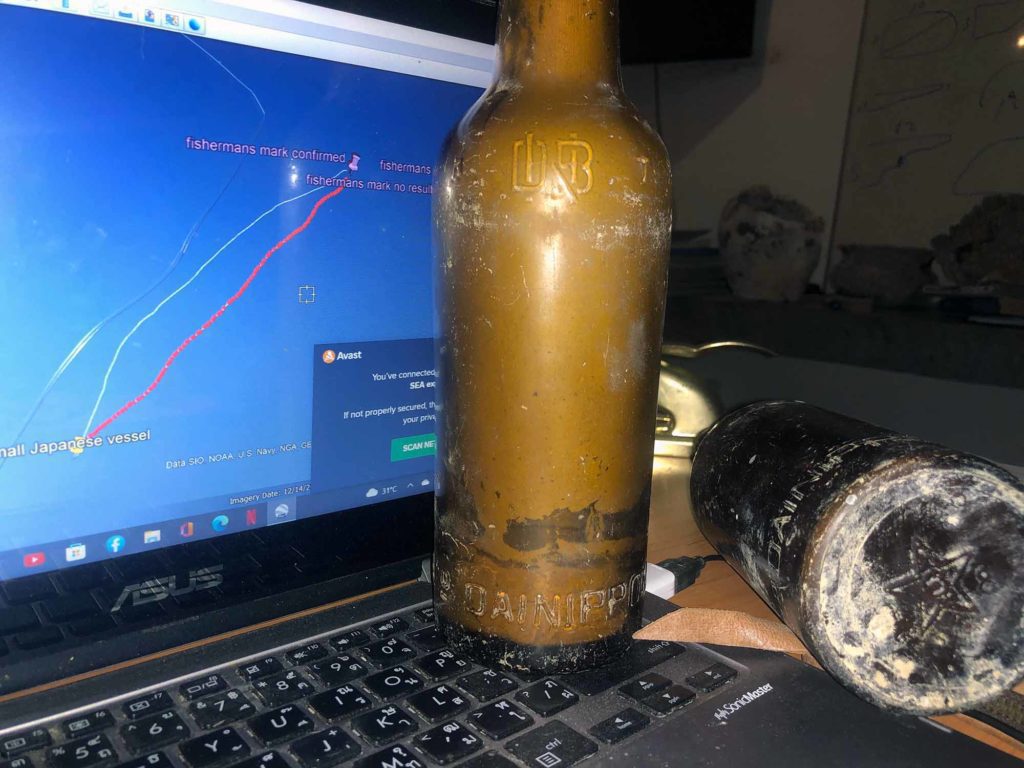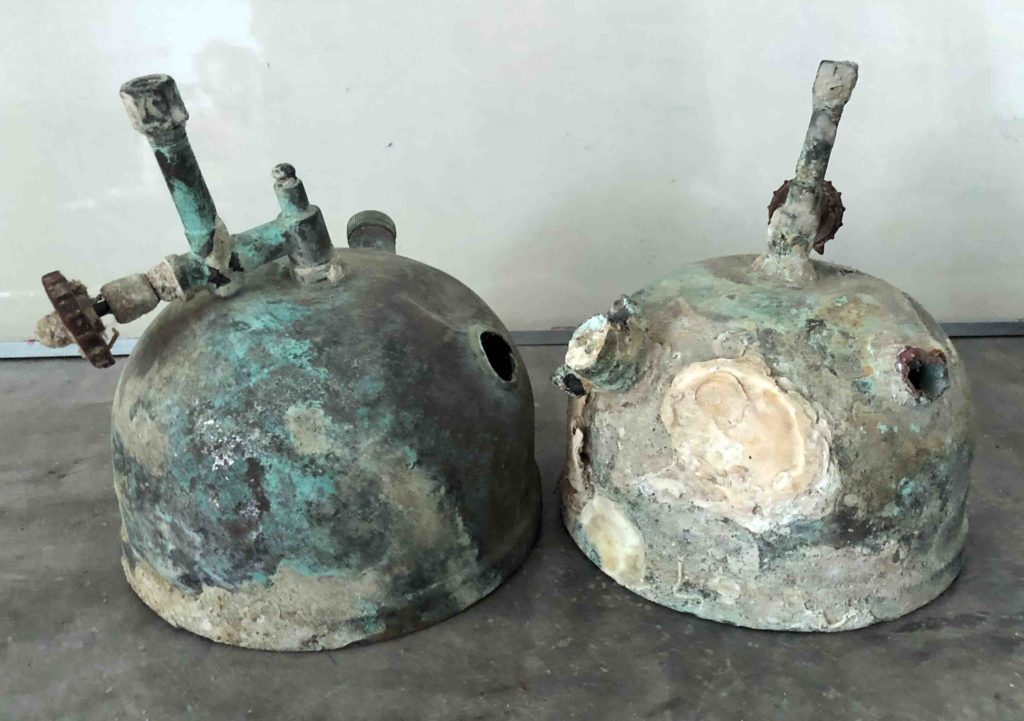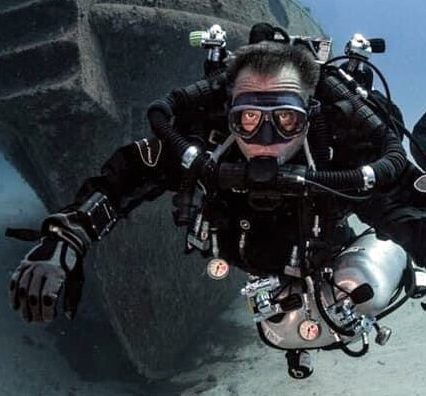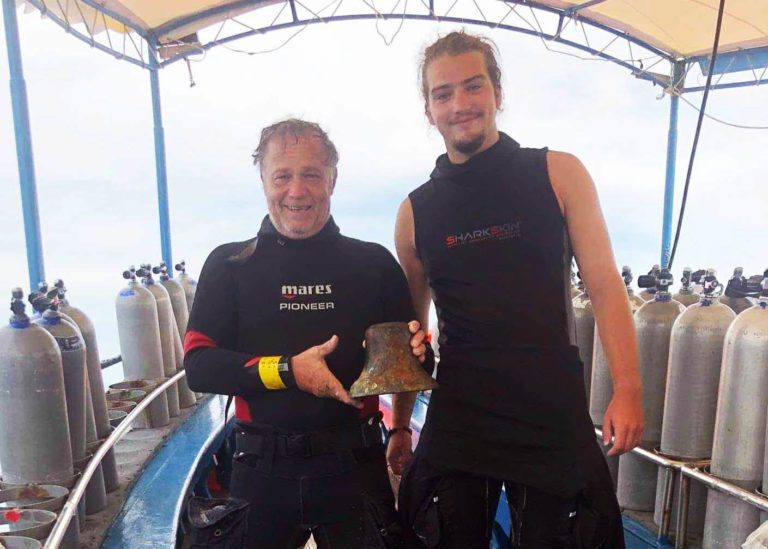Thailand-based wreck-hunter TIM LAWRENCE and his dive-team pulled this artefact off a shipwreck recently but he tells us: ‘I’m a bit frustrated with this bell – aren’t they supposed to clear up uncertainty?’ Can anyone out there help to fill the gaps…?
Captain Kai's Seafaring Life
29 May, 1945, Captain Kai, a veteran of the South China Sea, has spent most of 35 years offshore. After seeing at first hand steam’s evolutionary effect on commerce he feels saddened by its impact, and thinks poorly of what he considers the softer mariners that steam has produced.
Also read: Deported diver returns – but faces pipefish charge
Kai prefers the old-school men of sail. Nevertheless, in this time of war, he has to take what crew he can get. The war has seen rapid change in this remote corner of the world. Coastal trade is booming and he will continue to profit – if he can only stay afloat long enough.
Most experienced local seamen work on the bigger Japanese cargo ships that are being targeted by US submariners so, with seasoned sailors few in numbers, Captain Kai has to rely on local tradition to impart knowledge of the sea to his raw crew. He clings to tradition as the shadow from the yard-arm clings to the deck of his 200-ton schooner.
So far the Americans have left the smaller ships alone, but if rumours of losses are correct, it’s only a matter of time before the coastal trade becomes a target on the enemy’s periscope.
Eight bells ring across the deck, a change of watch every four hours, with fresh eyes to scan the horizon for signs of the enemy. Kai takes a deep breath. The ship’s bell sounds, reassuring and calming in the night air. He studies the horizon one last time. The offshore wind from the south-west will soothe their sleep.
Siam has largely been left alone. Unlike Burma, it is cashing in on lucrative trade between Singapore and Bangkok. Kai’s vessel, heavily overloaded with supplies, could make a decent target. The Japanese are on the back foot now, his friends’ ships are fewer in number and the bell brings another change of watch.
The rhythm of his ship, tuned as it has been throughout his working life, soothes his nerves.
The USS Hawkbill's Hunt
29 May, 1945, Commander Scanlon orders his Balao-class submarine the USS Hawkbill to periscope depth. With little power left in the batteries, he needs a dark patch of sea in which to surface and allow the diesel engines to run. The tide of war has already turned, but Japanese aircraft remain a clear and present danger.
Hawkbill (SS-366) was commissioned in May 1944. Meant to be named after the sea turtle, the ‘s’ in “hawksbill” got lost somewhere along the way.
Cdr Scanlan surveys the surface to the north-west and sees some small fishing vessels out from Chumporn. Finally, he decides that it’s safe to surface, and as the hatches open the fresh air jolts his crew from their ease. Atop the conning tower, the captain revels in the monsoon breeze.
Some days have passed since Cdr Scanlon’s last attack, on the infamous Japanese mine-layer INJ Hatsutaka. The action had felt like vengeance for the loss of his friends on the USS Lagarto. But bittersweet the taste of victory – his crew are only halfway through the patrol and, after the intensity of that last action, he is seeking a softer target to settle them.
The Sinking of Captain Kai's Schooner
A look-out raises the alarm, and Cdr Scanlon peers through his binoculars. A two-masted schooner is unwittingly closing the distance between them, heading for Singapore. He orders his command to dive to periscope depth and waits for the sub’s next victim to approach.
The sun is rising behind the schooner, making it easy to track. Closing the distance, Cdr Scanlon looks at the skies before giving the order to surface again. The gun crew makes ready the 5in deck gun.
On the schooner the bell rings out: all hands on deck! Extra sail is frantically rolled out, and the vessel changes direction to run with the wind in a misguided attempt to outmanoeuvre its attacker. Cdr Scanlan hails the schooner.
Cpt Kai, rudely woken by the submarine’s presence, rushes to the bridge, realising that his vessel’s 8 knots are no match for the submarine’s speed. The war has caught up with him.
Cdr Scanlan orders all the schooner’s hands to the lifeboats. They heave on the oars, and put some distance between themselves and their attacker. All they can do is watch as the 5in gun’s shells splinter the wood in the teak decking – then Kai’s beloved ship slips slowly beneath the waves.
The masts cling to the surface for what seems an eternity. Then, in the blink of an eye, the schooner is gone.
Davy Jones’ Locker's Initial Exploration
15 May, 2008, A team of divers from Davy Jones’ Locker on the island of Koh Tao are loading a 6m RIB. We’re acting on a hunch that a lightly displaced vessel such as a 200-ton schooner loaded with a light-displacement cargo would not sink directly to the bottom of the western Gulf of Thailand but drift with the prevailing wind, slowly reaching the seabed after travelling some distance from where it had left the surface.
Researching wartime records, we have some firm targets directly aligned with the south-west monsoon winds. The marks are to the north-east, and we have been waiting for a clear spell.
It’s a bright, calm morning, and we cover the distance quickly. Koh Tao is still visible by the time we reach the site. A fisherman has placed a rope made with palms attached every 3m over the wreck-site, complicating our efforts to scan it effectively with the echo-sounder. Nevertheless, we decide to enter and descend on the palm rope, wondering at the schools of fish this feature has attracted.
We have detected a slight rise on the sounder but are unsure of its nature, given the many undulations at the bottom in this area. A thick thermocline at 40m complicates the search.
Attaching a distance line at 48m, we run the line out to the 10m pre-marked on the reel and begin a circular search. In 1m visibility, looking into the dark, the sea plays games with our imaginations.
Resisting the temptation to chase shadows, we manage to swing through an arc on the distance line. Slowly pieces of plate and brass lamps begin to appear, before we see a hollow filled with bottles and the remains of a ship’s cargo. Containing our excitement, we begin to search for clues as to the identity of the wreck.

Unearthing the First Clues
The first evidence comes from recovered beer bottles. Marked with English, Japanese and Chinese writing, we can read the words “Danippon Brewery Co Ltd”. This Japanese company, as we learn later, was established in 1907 and closed in 1949, so we’re on the right track.
Large water-containers, plates, gas lamps and fish-sauce bottles bear testament to the diversity of the cargo. We find no sign of engines, but what we do know is that the wreck lies directly in line with that monsoon wind.
Eventually we surface after completing our decompression obligation, sure that the wreck-site is that of the schooner lost all those years before.
Details of the Wreck
We lack definitive evidence, however. Over the following years, we gradually build on our knowledge. The wreck is 40m long with a 5m beam. It has a timber hull and rises 4m from the seabed.
Poor visibility often makes our diving challenging. Disturbing sediment can reduce the visibility to zero and increase the risk of losing the line, so we practice our lost-line drills regularly.

The Discovery of the Bell
1 May, 2022, Thirteen years have passed without any further clues being uncovered. We set out to look at the wreck-site once again, taking with us a new technical diver, Sam Bean, who is only 19 years old. Curious to see if time and the elements have uncovered anything fresh, we slip beneath the waves and descend.
At the bottom we attach our distance-line and begin our slow journey around the mound of the wreck, checking depth regularly to aid our navigation, our minds still tempted into diversions by the shadows.
Part of the keel remains to aid our progress. Out of the murky water one plate and then another appears, part of that cargo bound for the Singaporean market.
Turning the dive, we retrace our distance line along the remains of the keel. Sam reaches out ahead of him and pulls what at first appears to be an unremarkable object from the debris.
Completing our decompression, we climb back onto the boat. I reach into the bag and out comes what is now the unmistakable shape of which divers dream – a bell.
Trying hard to contain our excitement we turn the RIB for land, and the next phase of our search.
Postscript: Puzzles and Conjectures
The only letters we have been able to distinguish on the bell are “GNO”. A researcher might be able to identify the mark, though even then it would not be definitive proof of the identity of this ship or whether it indeed sank on 29 May, 1945, because the war records are too vague.
Neither does Hawkbill’s log mention the size or type of vessel it sank that day, though the scale of the wreck-site certainly suggests a 200-ton vessel. My own belief is based around the lack of other marks in the area, and clues from the cargo we have recovered – as well as my own experience of being on a ship of similar displacement that sank from beneath me in the south-west monsoon!
On that occasion we had a 6m RIB in tow and marked the position as the vessel left the surface. We returned to the location six weeks later, ran a seven-hour search and located the wreckage just over 20km from where it had sunk – exactly in line with the monsoon winds. But that’s a story for another day.
The rest is conjecture, and Captain Kai is my invention, but perhaps someone out there knows whether there was indeed a Kai who lost his ship here during World War Two to a US submarine.
About TIM LAWRENCE

TIM LAWRENCE owns Davy Jones’ Locker (DJL), based on Koh Tao in the Gulf of Thailand, a centre that offers divers the chance to further their skills beyond the range of recreational scuba diving. A renowned technical wreck and cave explorer, and a member of the Explorers Club New York, he is a PADI / DSAT Technical Instructor Trainer. (Photo: Mikko Paasi)


Koh Tao is a busy diving destination.
To find a wreck so close to the island is incredible.
I love Tim Lawrence’s stories behind the wrecks he discovers. Eagerly awaiting part 2.